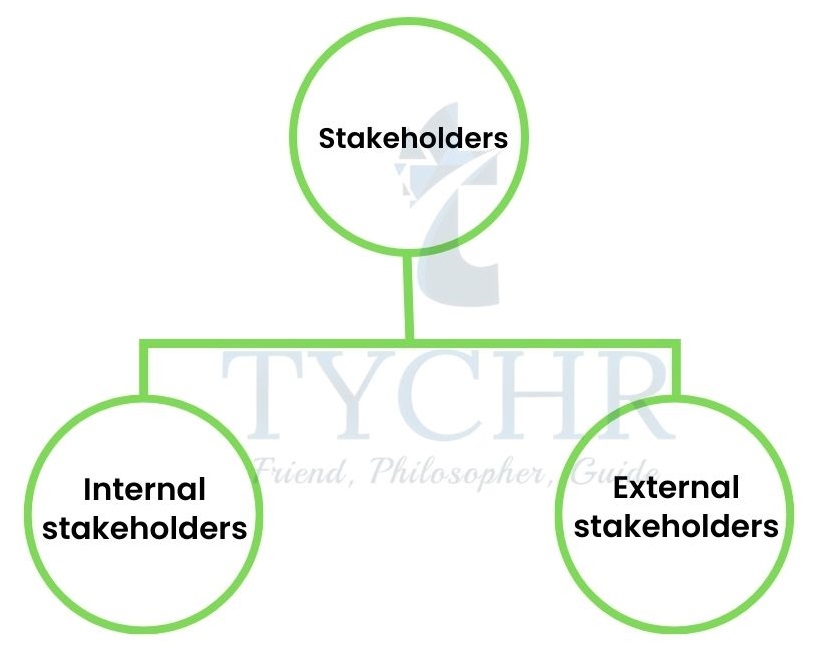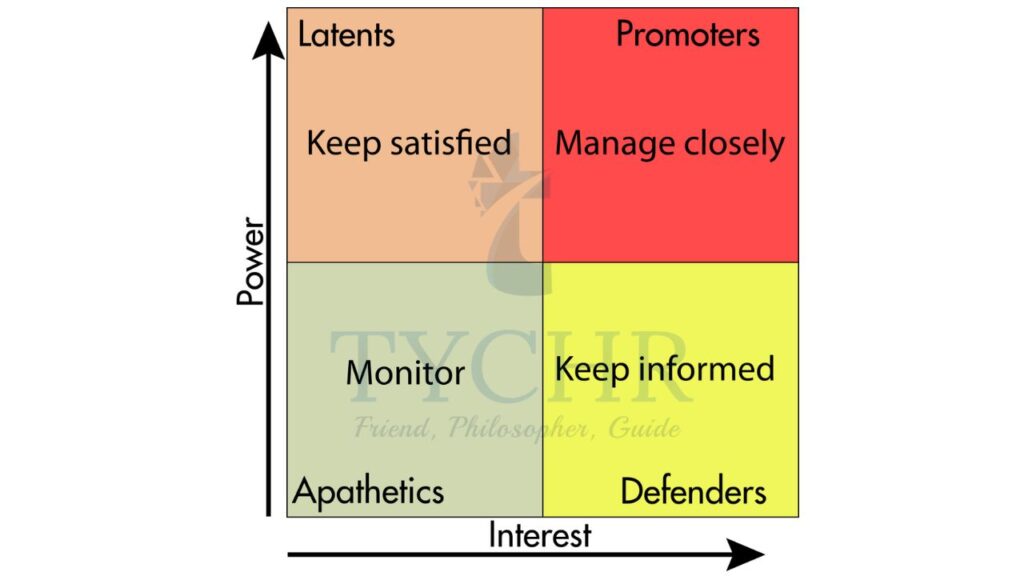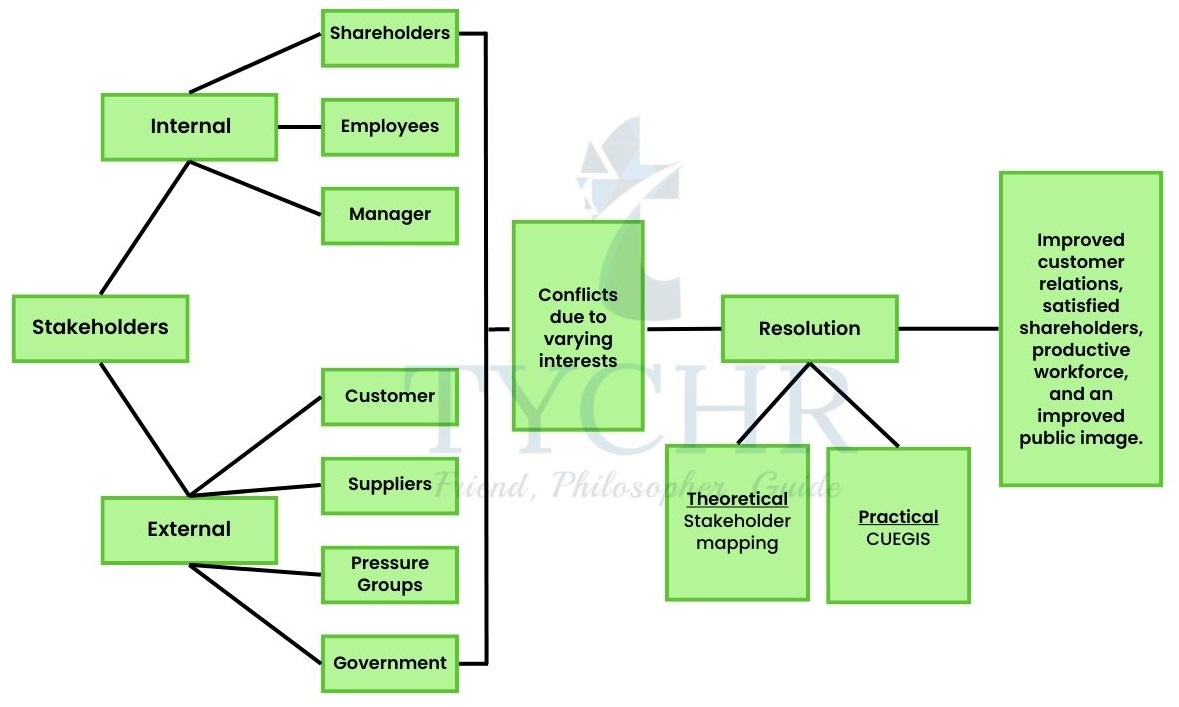Stakeholders Notes
Stakeholders are individuals or groups with an interest in a business and its activities. This study note explores the various types of stakeholders in IB DP Business Management, their potential impact on a business, and how businesses can effectively manage stakeholder relationships. Understanding stakeholder interests and influences is crucial for decision-making and achieving business objectives in the IB Business Management syllabus.
Have you heard of the term ‘stakeholders’ before?
If not, let us try to understand the meaning of the term ‘stakeholders’ first.
Any person/organization/group that has a stake(vital interest) in a particular business organization and is affected by its activities and performance is counted as a stakeholder for that company.
Stakeholders are both internal and external.

- Those that are directly involved in the operations and strategies of the organization and are the parties within the organization are defined as internal stakeholders. These are employees, shareholders, managers and directors of the company who exercise a potential influence on the performance of the business and are largely affected also.
- External shareholders represent the parties outside the organization. They are the entities which are indirectly impacted by the activities, goals, policies and performance of the business. These include customers, suppliers, creditors, competitors, government and society at large.
Internal stakeholders
Employees
As American comedian, Fred Allen said, ” Treat employees as partners and they act as partners “. Human resources are the best asset of the organization. Employees have an influential role to play in the performance and success of the company because they are the people who work for the company. Motivating them by taking care of their financial benefits and working conditions is important so that they stay dynamic and loyal to the company.
Shareholders/Stockholders
Shareholders are the primary stakeholders of the company. The capital of the company which is divided into small shares are purchased by these folks and hence they are the owners of the company. They possess voting rights and are involved directly in the strategic decisions of the company. They also have a share in the profits/losses of the company and the portion of profit which is distributed among them is known as dividend.
Common mistake
Many students confuse the term shareholder with stakeholder and use them interchangeably. But these are two different terms. Shareholders are one of the internal stakeholders’ groups whereas stakeholders include all the groups/ parties that have an interest in the company.
Managers and directors
- Managers are the people who oversee the daily operations of business.
- Directors are the senior executives who have been elected by the company’s shareholders to direct business operations on the behalf of their owners.
External stakeholders
Customers
- As American creator Michael LeBeouf said, ” A fulfilled client is the best business methodology of all.”In the growing pace of competition, meeting customers’ needs and expectations in terms of both quality and price is vital to the survival of any business because they are the standing pillars of any business entity.
Suppliers
- Suppliers provide a business with stocks of raw materials, finished goods, commercial services, etc. to produce goods and services.
- Businesses strive to maintain a healthy relationship with the suppliers to receive the quality stocks on time and at reasonable prices. A good relationship with suppliers also means provision of preferential credit terms.
Pressure groups
- These include organizations/individuals who seek to place demands on organization and pressurize them to act in a certain way, by adopting some of the possible actions such as boycotting, protesting, lobbying, direct action.
- These include business groups, religious groups, student associations, trade unions, NGOs, etc. Few examples of pressure groups in India are NSUI, RSS, AISF.
Competitors
- These are the rivals/opposition parties to a business entity. For example- Dabur India faces competition from companies like Himalaya, Patanjali, Baidyanath, etc.
- Competitors are the external stakeholders who indirectly compel the organizations to be more innovative and creative to counteract. The companies face this competition by strengthening their weaknesses and capitalizing on the opportunities.
Government
- Another significant external stakeholder we are left to discuss is the government. Government interventions have both positive and negative influence on businesses. It might introduce incentives such as subsidized rent and tax concessions that may essentially benefit these corporations while sometimes few interventions can also constrain business activities.
NOTE: The government may also have a financial stake in a business organization. In that case it may have direct interest in the company as a shareholder.
Do you think conflicts can arise among stakeholders of the same organization? If Yes, what should be the reason for such a conflict Tired? Let us cover the last topic and set a full stop to the chapter.
Stakeholders and the CUEGIS concept
We know that all the stakeholders’ expectations cannot be met simultaneously but there is a solution available for the same.
- There is a best-fit theoretical solution to address the interests of stakeholders, available in the form of a model known as Stakeholder Mapping.

- It is a model that helps in determining the stakeholders’ interests and their relative influence on the business. Their actions are prioritized and categorized accordingly by the managers. But when it comes to seeking a practical solution for this, CUEGIS concept comes into application. By CUEGIS, we mean change, culture, ethics, globalization, innovation, and strategy.
- The conflicts among the stakeholders are dealt with in different ways depending on various factors such as the culture and ethics of the corporate, leadership style of the manager, strategic policies of the organization, dynamic changes in the external environment, etc.
SUMMARY:
We can have a look at the chart below to get a final summary of all the concepts that have been discussed in the chapter above.

Stakeholder engagement is vital for business success. This study note has covered different stakeholder groups, their interests, and strategies for managing stakeholder relationships. Applying these concepts to real-world business scenarios and case studies is essential for developing a deeper understanding. For personalized support in IB DP Business Management, including stakeholder engagement and other topics, consider working with a tutor. TYCHR connects students with experienced IB Business Management HL & SL tutors who can provide tailored assistance. A strong understanding of stakeholders is crucial for success in IB DP Business Management.

